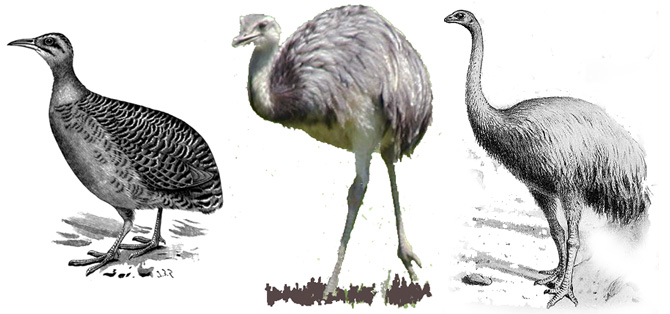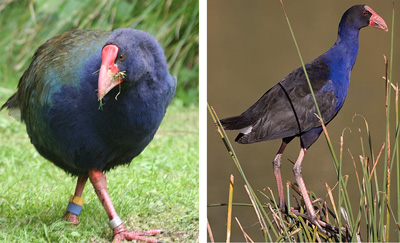‘Moa’s Ark’ vs Noah’s Ark

(Images from Wikipedia.org)
The headline of the Massey University (New Zealand) press release was certainly intriguing: “Bird molecules challenge to Moa’s Ark theory”.1
Not Noah’s Ark. Moa’s Ark. The ‘Moa’s Ark theory’ basically says that New Zealand’s animal and plant life evolved ‘largely untouched’, i.e. isolated in New Zealand from life in the rest of the world, over a period of 80 million years.2
The press release referred to a recent review article in The International Journal of Avian Science, by Steven Trewick and Gillian Gibb, both of Massey University. The review explained that the ‘Moa’s Ark’ idea had been encouraged by “the potential for an old geological age of New Zealand”.3
It’s hardly surprising that long-age notions fuel evolutionary ideas. Evolutionary theory needs long, long periods of time. Evolutionary ideas had been around long before Charles Darwin but ‘thanks’ to long-age geologists in the 18th and 19th centuries such as Charles Lyell actively seeking to overturn traditional young-earth beliefs, Darwin’s ideas were able to get traction.4
Hence an 80-million-year-old New Zealand opens the conceptual door to an evolutionary ‘Moa’s Ark’. However, as Trewick and Gibb reported in their review of the ‘molecular phylogenetic evidence’ from native birds, including now extinct birds such as the moa, ideas about flightlessness indicating “ancient evolution” have had to be dramatically revised. According to Dr Trewick:

“Evolution can happen quickly given the right circumstances.5 For example, we now know that most moa species evolved in the last three or four million years,6 which is young compared to the earlier ideas that related diversification to a much older 80 million year history of New Zealand. Although flightlessness could indicate ancient evolution, the trait is in fact relatively common among birds throughout the world, especially on islands. Our own takahe is an example of a species that has evolved flightlessness in recent geological time, whereas its flying cousin the pukeko has arrived in New Zealand in the last few hundred years.”
Evolutionists have in fact had to change their thinking about the origins of a wide suite of New Zealand’s flora and fauna. “A consistent finding is that the biota is much more youthful than previously thought,” reported the Massey University press release. It said that a very high proportion of the birdlife in New Zealand has its origins in Australia, with some species being “so like those in Australia they cannot be distinguished even with molecular data.”, 7 An exception was the moa—its DNA most closely matched that of the tinamou of South America, which can fly. This and other molecular data has forced a radical rethink of the origins of flightless birds worldwide. In short, the molecular and other evidence points to New Zealand’s flightless birds being the descendants of birds which flew to New Zealand, and which are just like flying birds we see elsewhere in the world today. So much for the Moa’s Ark theory!
Not surprisingly, there was no mention of Noah’s Ark anywhere in either the Massey University press release or the journal paper. No, all the commentary was directed at how the new data challenge the Moa’s Ark theory. There was no withdrawal of the challenge from evolutionary theory to the Noah’s Ark account.8 Evolutionary notions might need to be rewritten in the light of new evidence, sure, but the belief that evolution explains our origins is never questioned. It is an article of faith. As is the millions-of-years—although moa origins having been revised downward from ‘ancient’ to ‘just’ four million years or so is a dramatic shortening of evolutionary timespans, there seems to be an aversion to even considering the possibility of shortening it further to a thousands-of-years history.
But if the researchers had indeed taken time to consider the facts before them from the perspective of Genesis being actual history, they would see that New Zealand’s fauna fits with a Creation–Noah’s Ark perspective of origins and biogeography. From that perspective, the earth’s post-Flood land areas about 4,500 years ago were completely devoid of all land animals and birds, as any creature with “the breath of life in its nostrils” (Genesis 7:22) had perished in the Flood, unless it was on the Ark. The process of repopulating the earth with land animals radiating out from the Ark’s landing site in the Middle East was made easier by the presence of land bridges connecting (or almost connecting) Asia to the Americas and to Indonesia/Papua New Guinea/Australia during the Ice Age.9 But the 2,000 kilometres of deeper ocean waters separating Australia and New Zealand proved a most effective barrier to land animals.
(Even today, New Zealand is still free of snakes. In contrast, snakes had recolonized Krakatau10 within 25 years of the Indonesian island having been totally denuded by its catastrophic 1883 volcanic eruption.)
Consequently, the only types of creatures on the Ark to have lived in New Zealand before human occupation were those capable of flight. (For many years bats were the only mammals in New Zealand, apart from seals on its shoreline.) As the first arrivals began to breed, any hatchlings with some kind of mutational disorder rendering them flightless were able to safely move into a vacant ecological niche that on other continents would have been occupied by ground animals. In the absence of ground-dwelling predators (absent because they were unable to make the sea crossing), the flightless moa, kiwi, kakapo and notornis survived and multiplied. Eventually, however, humans (the descendants of Noah) reached New Zealand’s shores (see Maori memories of the Creator) and it seems that the moa was a particularly attractive target for Maori hunters, and its numbers quickly dwindled. Other impacts from human settlement, e.g. habitat clearing and introduced predator mammals, continue to pose survival challenges to New Zealand’s remaining flightless birds.
Note that all of this fits perfectly with the Bible’s 4,500-year post-Flood history much better than the millions-of-years evolutionary scenario. The extinction threat facing New Zealand’s flightless birds (in common with many other animal and bird species around the world) is a reminder that we live in a sin-cursed world ‘in bondage to decay’ (Romans 8:19–22) with death an ever-present reality. This is in stark contrast to the original ‘very good’ world in which there were no mutations, and so no death of the unfit. And crucially, the onset of flightlessness in no way supports microbes-to-moa evolution, as losing the ability to fly is of course a loss of information, not a gain. (Evolution demands that something like bog scum became birds, but the changes in living things observed today that are so often presented as evidence of evolution are in fact downhill changes—as we’ve so often pointed out before, the evolution ‘train’ is going the wrong way!11)
New Zealand’s avifauna is best described by the Noah’s Ark account of history, not the Moa’s Ark fiction—no matter how much twisting is done to the evolutionary storyline to accommodate newly observed evidence. And elsewhere, too, the Bible’s account makes much more sense. Evolutionists once believed that the giant flightless birds—moas, ostriches, rheas, emus and cassowaries—were all related and were a primitive group which had not yet evolved the ability to fly. Now they believe those flightless birds evolved from flying ancestors and are not from a common stock. This belief—no common ancestor and loss of ability (to fly)—of course fits a biblical perspective better than an evolutionary one!12
References
- Massey University press release, Bird molecules challenge to Moa’s Ark theory, http://www.massey.ac.nz/massey/about-massey/news/article.cfm?mnarticle=bird-molecules-challenge-to-moas-ark-theory-04-05-2010, 4 May 2010. Return to text.
- According to the evolutionary view, New Zealand is said to be 80 million years old, i.e. since “the Gondwana supercontinent” is mooted to have broken up. Return to text.
- Trewick, S., and Gibb, G., Vicars, tramps and assembly of the New Zealand avifauna: a review of molecular phylogenetic evidence, IBIS—The International Journal of Avian Science 152: 226-223, 2010. Return to text.
- See: Walker, T. and Catchpoole, D., Charles Lyell’s hidden agenda—to free science “from Moses”; creation.com/lyell Return to text.
- The ‘speed’ of changes in living things is something that evolutionists have had to put a brave face to, given the long-held mantra that ‘evolution’ is a slow and gradual step-by-step process over millions of years. See: Catchpoole, D., and Wieland, C., Speedy species surprise, Creation 23(2):13–15, 2001, creation.com/speedy. Note that the observed changes are in no way evidence of microbe-to-moa evolution, but rather simply a reflection of neutral or information-losing mutations, along with the built-in variety in each of the created kinds that is due to sexual reproduction and the built-in capacity to adapt to different environments.. Return to text.
- The stated ‘millions of years’ derive from a molecular clock approach to looking at the DNA differences, but the idea is fraught with problems. See Debunking the ’molecular clock’. Return to text.
- Trewick and Gibb’s review (Ref. 3) also pointed out that “NZ’s avifauna is a subset of Australia’s, which is in turn a subset of global diversity”. Return to text.
- Evolution and Genesis are utterly incompatible, as many articles on creation.com demonstrate. (See, e.g., Do I have to believe in a literal creation to be a Christian?) Aside from the many historical, geological and paleontological contradictions, from a purely biological perspective a belief that evolution explains the existence and biogeography of the world’s creatures immediately rules out a Noah’s Ark (i.e. the Noah’s Ark and global Flood event documented in Genesis 6–9). Biology textbooks promoting evolution are in complete opposition to the biblical teaching that all the world’s air-breathing land animals and birds are descendants of creatures that came off the Ark at its landing place in the Middle East only about 4,500 years ago. Return to text.
- See chapter 16, ‘What about the Ice Age’, and chapter 17, ‘How did the animals get to Australia?’ in Batten, D. (Ed), et al., The Creation Answers Book, chapter 19: ‘What about the dinosaurs?’, pp. 235–253, Creation Ministries International, Brisbane, Australia, 2006. Return to text.
- Sometimes rendered in English as ‘Krakatoa’. Return to text.
- See Wieland, C., The evolution train’s a-comin’ (Sorry, a-goin’—in the wrong direction), Creation 24(2):16–19, 2002; creation.com/train. Return to text.
- Birds, with their capacity for flight, are likely to have been at the forefront of the dispersal into the devastated post-Flood landscape, as they were at Mount St Helens, following the devastating 1980 eruption. Any flightless mutant offspring of birds reaching the most distal land areas from Ararat (viz., southern Africa, Australia, New Zealand, and South America) did not have to face the predation selection pressures of similarly afflicted hatchlings closer to the Ark’s landing site. Hence the ostrich, emu, cassowary, moa and rhea were able to multiply in their respective habitats. Return to text.






Readers’ comments
Comments are automatically closed 14 days after publication.